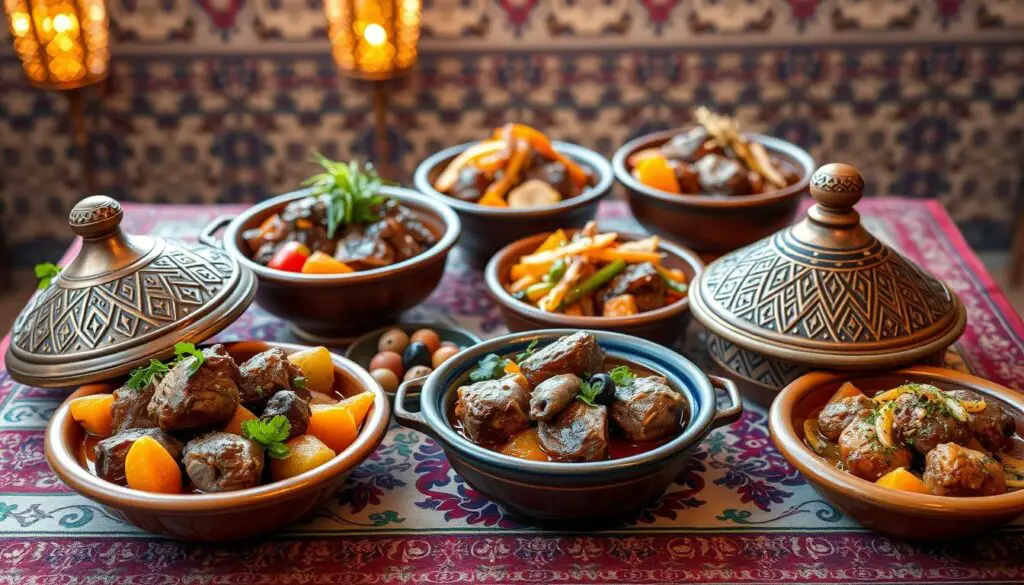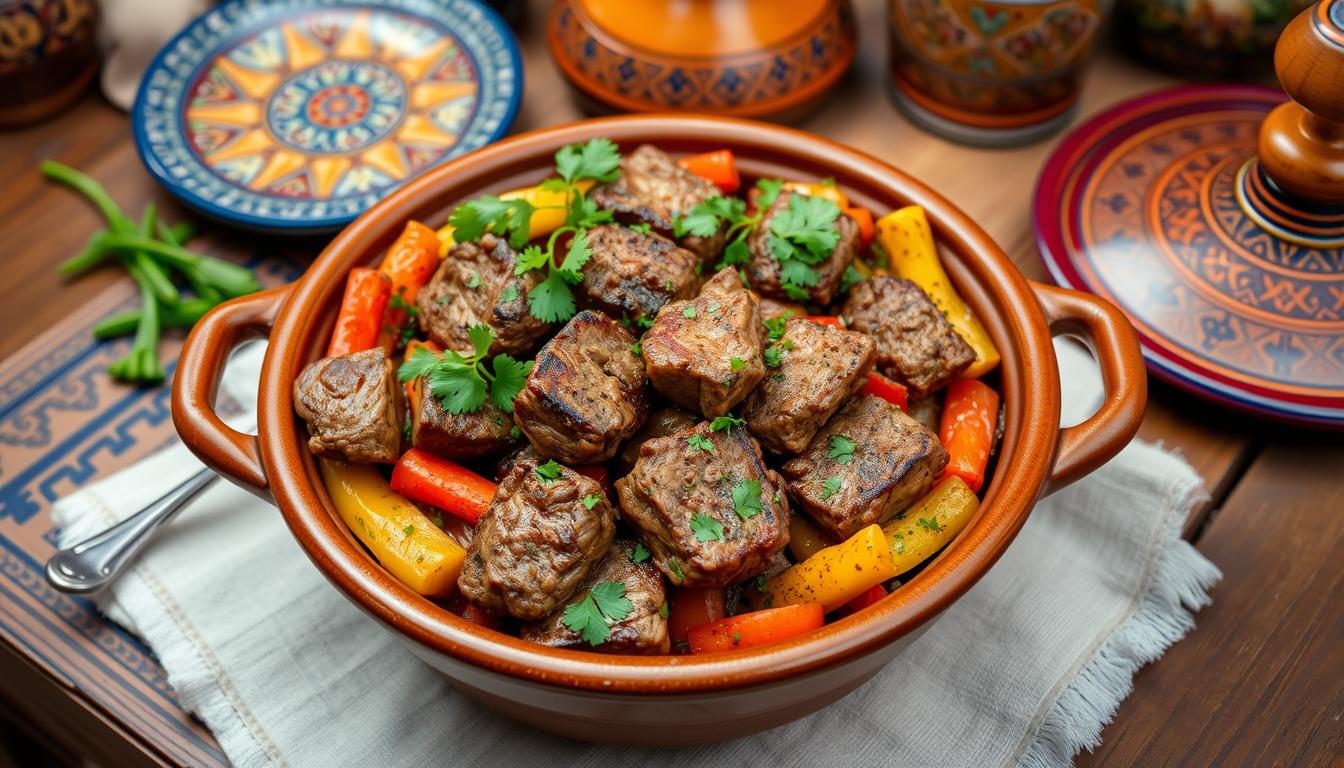Discover the true taste of North African cuisine with our authentic Moroccan Tagine with Lamb. This dish combines tender lamb with a mix of spices, vegetables, and dried fruits like apricots and pistachios. It’s a traditional cooking method that promises a unique and delicious experience for your family and guests.
Start by gathering your ingredients and letting the lamb marinate. Then, get ready to bring the vibrant streets of Morocco into your home. This recipe is perfect for creating a memorable family meal.

Key Takeaways
- This recipe serves two, making it ideal for a cozy dinner.
- Total cooking time is around 1 hour and 55 minutes, ensuring the lamb is tender and flavorful.
- The dish can be enhanced with a variety of spices for an authentic flair.
- Moroccan bread pairs perfectly with the savory lamb tagine.
- Leftovers can be stored in the refrigerator for up to three days.
Introduction to Moroccan Tagine Cuisine
Moroccan cuisine is a vibrant mix of Berber, Arab, and Moorish traditions. At its heart is tagine cooking, done in a special, conical pot. This pot ensures even heat and keeps moisture in, making meals tender and flavorful.
In Moroccan cooking, spices are key. You’ll find cumin, saffron, paprika, and cinnamon, blending sweet and savory. Meals are filled with fresh ingredients like vegetables, meats, and dried fruits. Eating together is a big part of Moroccan culture, with large portions shared among family and friends.
Authentic Moroccan tagines simmer meats with fruits like prunes and apricots for hours. This slow cooking brings out the flavors, making each dish a delight. Whether it’s lamb, chicken, or fish, the result is always delicious.
Exploring Moroccan cuisine means diving into the world of tagine. From Marrakesh’s street food to home kitchens, tagine is a treasured tradition. It connects people through generations of delicious flavors.
The Unique Cooking Vessel: Tagine
The cooking tagine is more than a pot; it’s a symbol of rich culinary tradition. It has a shallow base and a conical lid, perfect for slow cooking. This design lets steam circulate, making food tender and flavorful.
The tagine’s history is fascinating, tracing back to nomadic tribes and “One Thousand and One Nights.” Even the Romans used similar pots. Today, you can find traditional clay tagines and modern metal or ceramic ones.
To keep your clay tagine in great shape, cure it before first use. This step ensures it cooks well for years. If you want to try Moroccan cooking, a tagine is a great choice!
Ingredients Needed for Moroccan Tagine with Lamb
To make a real Moroccan tagine, you need to pick the right ingredients. These ingredients add depth and character to the dish. They include Moroccan spices, tender lamb, and vegetables that complement each other. Here’s what you need to make a delicious Moroccan tagine with lamb.
Essential Spices for Authentic Flavor
Moroccan spices are what make this dish special. You’ll want to use:
- Cinnamon: It adds warmth and sweetness.
- Coriander: This spice has a citrusy taste.
- Ginger: It brings a refreshing kick.
- Paprika: It adds a mild pepper flavor.
- Saffron: This spice gives a luxurious aroma and color.
Using these spices together creates the rich flavor that’s typical of Moroccan cuisine.
Choosing the Right Cut of Lamb
The quality of lamb you choose is key to a great tagine. You should use:
- Lamb shoulder: It’s tender and flavorful when cooked slowly.
- Lamb leg: Cubed into 1-inch pieces, it’s another excellent choice.
These cuts ensure your dish is juicy and full of flavor. They break down well during cooking.
Vegetable and Fruit Additions
Vegetables and dried fruits add flavor and texture to your tagine. Key ingredients include:
- Onions: Sautéed until soft, they create the base flavor.
- Potatoes: Sliced into rounds, they soak up all the flavors.
- Dried fruits: Apricots and dates add natural sweetness.
- Fresh herbs: Parsley or cilantro add freshness and color.
These ingredients work together to make a comforting and flavorful dish. It’s a true example of Moroccan culinary traditions.
Preparation Steps for the Moroccan Lamb Tagine
Preparing Moroccan lamb tagine is a few steps away from a delicious meal. It starts with marinating the lamb, layering ingredients, and choosing the right cooking method. These steps help bring out the authentic flavors and cater to different cooking styles.
Marinating the Lamb
Marinating lamb is key to infusing it with spices. Mix spices, olive oil, garlic, and salt to make a tasty marinade. Let the 600g of diced lamb soak in it for a few hours. Adding saffron and cinnamon will make it even more aromatic.
Layering the Ingredients in the Tagine
Layering ingredients in the right order is crucial. Begin by cooking onions until they’re sweet and caramelized. Then, add the marinated lamb. Mix in medjool dates and seasonal veggies in layers. This way, you get a dish full of flavor and texture.
Cooking Method: Traditional to Modern
There are many ways to cook a tagine, depending on what you have and how much time you have. Traditionally, a tagine pot is used for slow cooking, making the lamb tender. You can also use a Dutch oven or slow cooker for similar results. If you’re in a hurry, a pressure cooker can cook it in 45 to 50 minutes. But, simmering it for 2 to 2 1/2 hours is best for rich flavors.
Cooking Time and Temperature
Making a Moroccan tagine is all about the right cooking time and temperature. It usually takes 1.5 to 2 hours in a traditional pot. This makes the lamb tender and the flavors blend perfectly. For slow cooking, keep the temperature between 300°F to 325°F. This helps make the dish even better.
Different ways to cook affect the time needed:
| Method | Cooking Time | Notes |
|---|---|---|
| Pressure Cooker | 45-50 minutes | Quick cooking method, tender results |
| Traditional Pot | 2-2.5 hours | Medium heat, good for flavor infusion |
| Tagine | 3 hours or more | Best for maximum tenderness |
This slow cooking method tenderizes the lamb and deepens the flavors. Patience is key. The longer it cooks, the richer and more aromatic the dish becomes.
Serving Suggestions for Moroccan Tagine with Lamb
When serving tagine, how you present it matters a lot. Traditional Moroccan lamb tagine is best shared in a family-style setting. This makes the experience more enjoyable. Here are some tips for serving and presenting your tagine.
Ideal Accompaniments
Fluffy couscous or crusty bread are great with lamb tagine. They soak up the sauce perfectly. Moroccan salads also add to the flavor. Here are some ideas:
- Moroccan Spiced Olives
- Moroccan Green Salad with Preserved Lemon Dressing
- Stuffed Green Queen Olives with Garlic Infused Olive Oil
- Ras al Hanout Roasted Carrots
- Moroccan Cheese Briouats
- Libyan Sharmoula
Each dish brings its own taste and texture. This makes the meal more enjoyable and varied.
Garnishing and Presentation Tips
Beautiful presentation is key to a great dining experience. Here are some tips:
- Use chopped fresh herbs like cilantro or parsley for a burst of color.
- Sprinkle toasted nuts, such as almonds or pistachios, over the tagine for added texture.
- Garnish with thinly sliced lemons or preserved lemons to complement the dish’s flavors.
Serving the tagine in its cooking pot makes it feel communal. It invites everyone to share. The designs of Moroccan tagines add to the meal’s beauty, highlighting its colors and textures.

Choosing the right sides and presenting the meal well makes any occasion special. It brings Moroccan flavors and hospitality to your table.
Storage and Reheating Tips for Leftovers
Proper leftover storage is key to keeping your Moroccan lamb tagine’s flavors. Store it in airtight containers after it cools down completely. This keeps it tasty and safe to eat. You can store it in the fridge for up to three days.
For reheating, try different reheating techniques to keep it delicious. On the stovetop, warm it gently over medium heat, stirring now and then. In the oven, preheat to 325°F (165°C), add a bit of liquid, cover with foil, and check the temperature until it hits 165°F (75°C).
Here’s a quick reference table summarizing the best practices for storing and reheating your lamb tagine:
| Storage Method | Duration | Reheating Technique |
|---|---|---|
| Airtight Container (Refrigerator) | Up to 3 days | Stovetop or Oven |
| Freezer | Up to 1 month | Thaw in Refrigerator, Stovetop, or Microwave |
Freezing is also an option. Just remember to remove potatoes first since they don’t thaw well. Let it cool, wrap it tightly, and label it before freezing. These tips will help you enjoy the rich flavors of lamb tagine even days later.
Versatile Variations of Lamb Tagine
Lamb is the traditional base of tagine, but it’s not the only choice. You can try different ingredients to match your taste and dietary needs. This makes tagine a versatile dish with many flavors and ingredients.
Meat substitutions can make a recipe better. Chicken is a popular choice in Moroccan cooking, alongside lamb. You can also use chickpeas or lentils for a vegetarian option. Adding vegetables like carrots, bell peppers, and sweet potatoes makes the dish nutritious and flavorful.
Sweetness adds depth to the dish. Using dried fruits like apricots, prunes, or raisins creates a mix of savory and sweet. This is especially true for special dishes like Mrouzia, a sweet mutton tagine enjoyed during the Feast of Sacrifice.

For those who love to try new things, making a table of lamb tagine variations can help. Here are some interesting options to inspire your next meal.
| Tagine Variation | Main Protein | Key Ingredients | Cooking Time |
|---|---|---|---|
| Classic Lamb Tagine | Lamb | Ras el Hanout, dried apricots, almonds | Over 1 hour |
| Chicken Tagine with Olives | Chicken | Green olives, preserved lemons, onions | 1 hour |
| Vegetarian Chickpea Tagine | Chickpeas | Tomatoes, carrots, spices | 30 minutes |
| Beef Kefta Tagine | Beef | Minced beef meatballs, eggs, tomatoes | Over 1 hour |
| Mrouzia | Mutton | Honey, cinnamon, prunes | 2 hours |
These lamb tagine variations show how flexible and beloved this dish is. They also highlight the key spices that make Moroccan cuisine famous. Trying these variations lets you be creative with your cooking and flavors, making every meal special and enjoyable.
Conclusion
The Moroccan lamb tagine is a journey into North African culture. It has a long history, starting in the 9th century. This dish combines sweet and savory flavors in a unique way.
A good tagine uses spices like cumin, saffron, and ras el hanout. These add a rich taste that makes the dish comforting. It’s perfect for Moroccan gatherings and traditions.
When cooking, slow cooking is key. It lets the flavors mix and the lamb get tender. This method also reflects the Berbers’ nomadic lifestyle.
The tagine pot’s shape is special. It keeps moisture in and adds flavor to every bite. This makes the dish truly delicious.
Trying this Moroccan dish is more than just eating. It’s a way to connect with culture and tradition. Sharing meals brings people together, making memories for family and special events.
